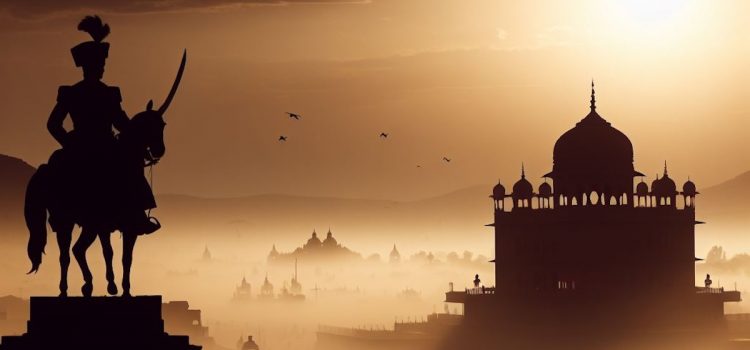
Who was Mir Jafar? Was he just a puppet of the East India Company and the British? How is he regarded today?
Mir Jafar served as a military general before becoming the first Nawab of Bengal under the authority of the British East India Company, making him the first ruler of the region dependent on the British for power. He’s a complicated figure with a problematic reputation still today.
Keep reading to learn the intriguing history of Mir Jafar.
Mir Jafar Seizes Power in Bengal
In The Anarchy, William Dalrymple explains that the history of Mir Jafar is entangled with the history of the East India Company (EIC). Emboldened by its victory against Siraj ud-Daula (the Nawab of Bengal), the EIC sought to expand its influence in Bengal by backing a coup and installing a puppet ruler who would support its interests. Dalrymple explains that Mir Jafar, one of Siraj’s generals, planned to overthrow the Mughal prince and was looking for allies. The EIC was known throughout Bengal for its military prowess, and the Jagat Seths, a wealthy family of financiers, offered a vast sum of money to the EIC and Robert Clive if they’d join Jafar in the coup. The EIC agreed, and Clive marched on the capital of Bengal with a force of English soldiers and sepoys—Indians who had been recruited into the company army and trained in British weaponry and tactics.
In its coup against Siraj, the EIC benefited from gaps in the other side’s military technology and experience with firearms—for example, EIC fighters knew to keep their gunpowder dry during a rainstorm with tarps, while their opponents, unfamiliar with firearms and their maintenance, didn’t. After defeating Siraj, the EIC installed Jafar as the Nawab of Bengal, but his dependence on EIC military power made the British the de facto rulers of the province. The Jagat Seths made good on their payment to Robert Clive, who returned to England the richest man in the country.
Bengal Under Mir Jafar and the EIC
Dalrymple reports that the newly-installed Nawab Jafar’s reign went poorly. He had little legitimacy in the eyes of the Bengali citizenry—he’d never been a Mughal prince and had seized power in a violent coup with the help of foreign merchants. Furthermore, having spent his entire career in the military, Jafar had little aptitude for governing, and his administration was beset by financial problems. Jafar’s soldiers grew mutinous since he could no longer pay them.
The EIC benefited enormously from Jafar’s ineffectual rule. Without checks on its power, the EIC oppressed the Bengali population with impunity. The company extorted merchants into selling goods at unfair prices, and its soldiers bullied, robbed, and arrested Bengali citizens.
(Shortform note: Dalrymple attributes many of Jafar’s financial problems to mismanagement and lack of governing experience. However, others looking back at this time have highlighted the exorbitant payments made to Clive and the EIC for their role in the coup, which cleaned out much of the royal treasury and put Jafar’s regime on a shaky footing from the outset.)
Mir Jafar Is Deposed
While the EIC enjoyed its impunity, the Jagat Seths were not pleased with Jafar’s flailing regime and decided to back a second coup. Dalrymple explains that Jafar had an ambitious son-in-law named Mir Qasim who thought he could do better. The Jagat Seths approved of him and asked the EIC to reprise its mercenary role. The EIC agreed. But, this time, instead of a lump sum of cash, it asked for tax collection rights in several portions of Bengal. This effectively made it an independent governing force with a steady stream of revenue. Qasim and the Jagat Seths agreed to these terms, and the EIC deposed its own puppet Jafar in a second coup.
| How Is Jafar Remembered? Jafar has a complex legacy. To this day, many Indians use his full name—Mir Jafar—as a shorthand for “traitor,” the way many Americans use “Benedict Arnold.” However, some argue that his reputation has been unfairly tarnished. In particular, Syed Mohammed Reza Ali Khan, one of Jafar’s descendants, has spoken out in his defense. He asserts that people judge his ancestor by modern standards of Indian patriotism and nationalism that were not widely held during the 18th century: Jafar is accused of betraying the “nation of India,” but during the 18th century, there was no such thing. Instead, 18th-century Indian nobles often fought with each other for power. Khan even points out that Siraj—Jafar’s predecessor—also seized power in a coup. |
Mir Jafar Is Reinstated
Dalrymple says the EIC soon grew tired of Qasim’s rule. A much more effective ruler than his father-in-law, Qasim raised taxes to balance the budget and pay soldiers their back wages. He rooted out corruption and built a strong administrative state. Qasim’s competence made him much harder to push around, and the EIC missed the impunity it had enjoyed under Jafar. Additionally, Qasim recognized the EIC as a rival and sought to counter its influence by eroding the privileges it had obtained from Siraj. The EIC voted to formally declare war on Qasim and reinstate Mir Jafar as Nawab of Bengal. Its military campaign prevailed and drove Qasim out of the region.
| What Constitutes a “Client State?” The EIC sought to turn the Nawab of Bengal into a client state—a government that is independent in name but subordinated to a greater outside power. Understanding the political theory behind client-patron relationships will clarify why the EIC preferred a weak, flailing regime to a strong one. Political theorists define a client-patron relationship using three criteria: Unequal power: The patron state is much more powerful than the client state. In this case, the EIC had a stronger military than the Nawab of Bengal. Reciprocity: The patron and client state have some sort of exchange. Usually, the client state will serve the patron’s economic and strategic interests in exchange for military protection. Informality: The client-patron relationship exists outside of formal and legal political arrangements. In this case, the Nawab was nominally independent but actually subordinated to the EIC. Mir Jafar’s reign fulfilled all three of these criteria. However, Mir Qasim violated the first by trying to equalize power in his attempt to build Bengal’s economic strength to rival that of the EIC. He then tried to violate the second criterion by refusing to prioritize the interests of the EIC. Understanding that Qasim wouldn’t acquiesce to a client-patron relationship, the EIC sought to dispose of his rule and reinstate Mir Jafar, who could continue serving as its client. |






